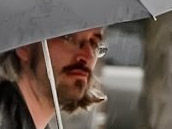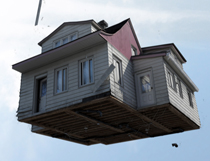There is a collage element of Martin’s art, both written and visual, that these reviewers appear to misunderstand; her blending of lines, concepts and the words themselves. Martin herself discusses her approach to collage in the interview with Cunningham:
After my divorce, I had a room and a table of my own, and I proceeded to fill my dinette table with cut-out words, my palette. On a cutting board (the “canvas”) I clustered words until they formed some kind of syntactical arrangement. From that original thread, the continuation was more or less intuitive. It was like piecing together a jigsaw puzzle. I’d look at that table full of words, let my mind do something else for a while, and when I came back to it combinations begin suggesting themselves. The poem would practically write itself.
She goes on to say, more specifically:
After Katrina, the poet Skip Fox, with whom I hung out in Lafayette, Louisiana, in the weeks following the disaster, encouraged me in the old day book tradition, so I filled some blank books with collages from National Geographic magazines and weird doodles, which provided for me some much needed post-Katrina therapy.
So where does image meet meaning meet collage in her collection of sonnets? Could Martin write such an overt post-Katrina poem? Would she even want to? The trauma of such experiences, and the joy and loss and discovery of leaving one home for another is inevitable in these poems, just as it was in Codes of Public Sleep, but these poems even taunt with such specifics. Sonnets placed earlier in the collection reference seismic shifts, writing how she “moves her hand to write / her lonely fiction. holds her pressure / to the heft. outs her story / for good.” and “my birthplace recedes into a blank page.” (“coma, amok”). The third poem in the fifteen-sonnet “parroted weeds” is even titled “katrina, tundra,” implying a movement from one state to another, and ending with the lines, “melting / snow gives back accidental scraps. frozen filth / and flying white flurries are both ideal states. will geese never fly north?” Another rare example of specifics in Martin’s sonnets comes later, in her three poem “the street names of toronto,” the second of which reads:
you were a brewer and a faithful methodist. prejudiced
against trees, you imported some of your prize bushes
from a brickyard in scotland. though considered ineffective,
you dreamed of living in a real castle
with thirty bathrooms and ornamental lakes
for the ponies. during the rosedale croquet riots,
the house of lords burned your effigy
at their clubhouse. after hanging the rebels,
you rebuilt your tavern and outlived all your accusers.
eventually your debts drove you to selling candy floss
in public dance halls and lunatic asylums. you left
instructions for your heart to be tucked away
in a place with no alcoholic beverages,
and now you are a street.
There are elements to Martin’s sonnets that read as experiments in intuitive movement, much in the way poet Fred Wah has discussed the “drunken tai chi” he’s explored in his own writing, through an ongoing series of pieces responding to artwork that began with his Music at the Heart of Thinking (Red Deer AB: Red Deer College Press, 1987). In her three Toronto-specific pieces, she writes unnamed individuals, wrapping what we can only, often, presume to be correct information about early city founders, this second poem on Joseph Bloor/e (1789-1862). Bloor, who founded Yorkville, ran a brewery in the Rosedale Valley near Sherbourne Street, and kept a hotel on King Street, the man for whom Bloor Street was named. But then, his name is still unspoken in the poem. Are these important facts? Are you presumed to already know? Martin’s poems suggest that these facts aren’t essential. What do you know of Bloor, with or without his final dropped “e,” and does it matter if I, speaking his name, am even correct? What hold does meaning have, here?





No Comments so far ↓
There are no comments yet...Kick things off by filling out the form below.